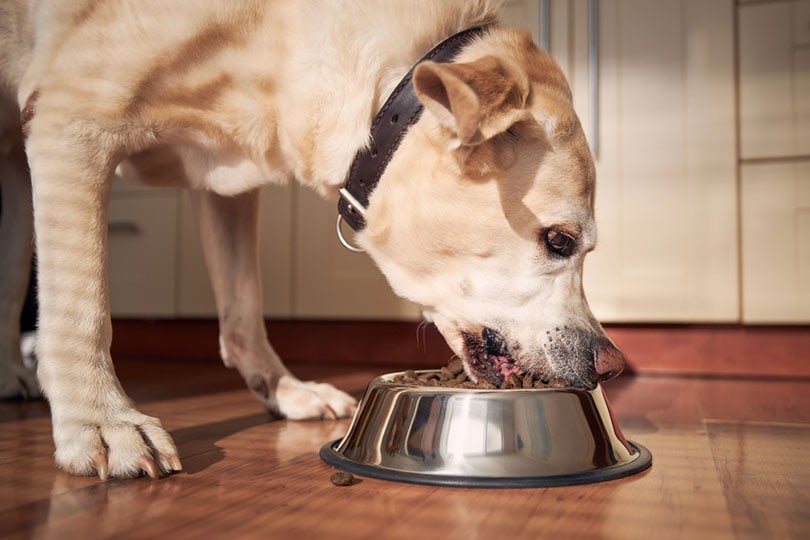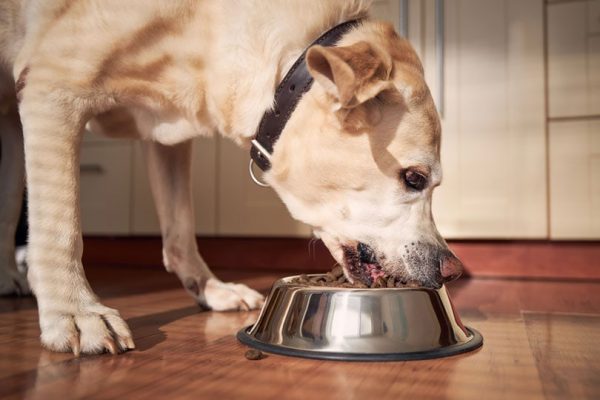There are so many different types of dog food, and your dog can have a lot of different things that make choosing dog food even more important and difficult. The following article highlights some of the signs that suggest things are off, and you may need to consider changing dog foods.
Before We Begin: A Word on Treats and Human Food
As you read the following signs that suggest your dog needs a diet change, do not forget the treats you feed them. Sometimes, it is not the food causing the problem but the dog treats and human food.
Daily treats, even dog training treats, can wreak havoc on a sensitive stomach. So just keep in mind that your dog’s diet is not just the food in their dog bowl, and you may need to control that source of calories, too. Suspicious sources of food that can also cause problems include the following:
- Human food
- Training treats
- Dog bones
- Dog chews
- Fun treats
- Dental treats
- Human food that is given by someone else
The 8 Signs You May Want to Change Your Dog’s Food
1. Allergies
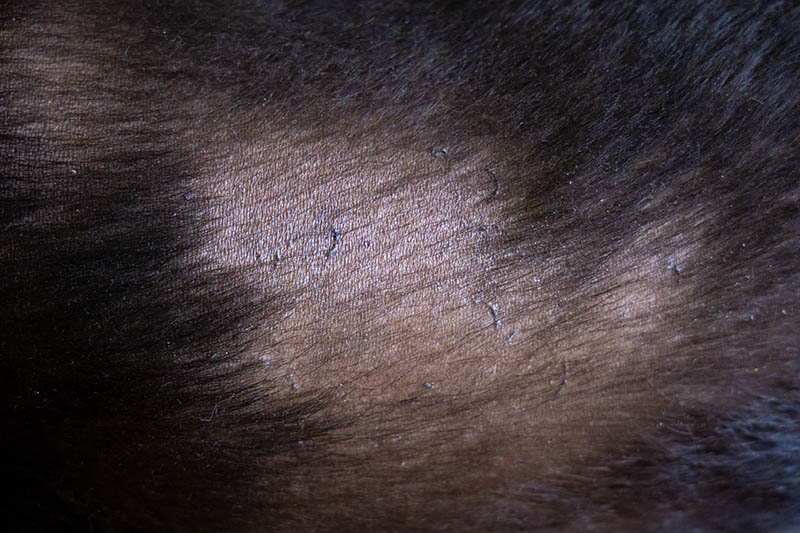
Allergies or food intolerance is probably one of the most important things that will make you change your dog’s food. Dog allergies are extremely common. If a dog is allergic to a type of food, they are usually itchy—their feet, ears, and belly will itch and can snowball into other problems.
Finding a food that does not trigger an allergic reaction can be a challenge and will probably take experimentation, time, and even a veterinarian’s advice and guidance. Many dogs are allergic to common dog food ingredients, such as chicken, lamb, and beef. Signs a dog may be allergic to their food can result in the following:
- Constantly licking or scratching their feet or belly
- Red, inflamed skin, particularly around their feet and belly
- Chronic ear infections
- Chronic or regular diarrhea
2. Sensitive Stomach
The biggest red flag your dog may need is a food that is easier to digest will be their poop. Irregular and intermittent diarrhea or even soft, inconsistent stool will likely get better on a more consistent and tolerable diet.
If your dog does have a sensitive stomach, changing their food—the baseline of their diet— may help them tolerate the small daily inconsistencies of treats and whatnot that happen during life. Look for the following signs:
- Chronic or irregularly regular diarrhea (diarrhea that pops up intermittently but consistently)
- Frequent vomiting
- Soft, inconsistent stool
3. Disease
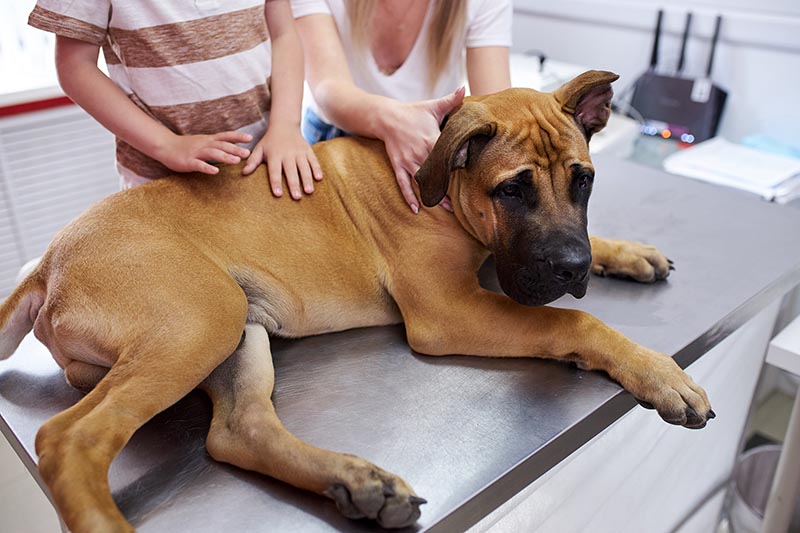
Some diseases do much better on a specific diet. There are excellent commercial diets that are designed specifically for them. Certain chronic diseases can make it difficult for your dog to maintain weight. For example, after a cancer diagnosis, it is common for a dog to lose weight. If your dog struggles to maintain their weight because of their sickness, it may be time to change to a higher-calorie diet that is easier to digest and absorb.
Diseases that may mean it is time to change a dog’s food include:
- Kidney disease
- Bladder/urinary tract disease
- Liver disease
- Digestive disease
4. Being Overweight
This is a big one. Finding a diet that helps manage your dog’s weight is hard to do. The simple story is to find a lower-calorie food and get your dog to exercise more. However, this is very difficult to do and may feel near impossible to realistically do. Don’t worry too much because you are not alone. It is hard. Here are some signs your dog’s food is too fattening:
- You cannot feel their ribs
- They have lost definition in their waist
- They have gained weight over time
5. Changing Life-Stage

Excluding all the other reasons, life-stage is a good reason to re-evaluate what your dog is eating. As long as they don’t have other health concerns that take priority as your puppy grows into an adult and then into a senior, they will probably have to change foods.
Puppy
Puppy food is specially formulated for…well…puppies. Adults who eat puppy food tend to struggle with their weight because it is usually high in calories, helping puppies grow quickly.
A puppy should eat puppy food from about four or six weeks old to nine to fifteen months old. That is a wide time frame. Breed plays an important part in that. Large breeds tend to take longer to grow and develop and so need extra nutritional support longer.
Adult
Adult food will probably make up most of your dog’s food over their lifetime. Adults are around one year old, and depending on their breed, they can be on this food for 7–10 years. Choosing the right adult food can be overwhelming, but it is an important decision and can improve your dog’s health and well-being.
Seniors
Seniors can also have different nutritional needs. As they get older, they may not get as much exercise, so they need a lower-calorie diet. They may need extra joint support for their creaky joints. Or they may have lost teeth and cannot crunch and chew hard food as easily.
As your dog ages, watch for these problems and consider if it might be time to change your dog’s food.
- Arthritis. The progression of degenerative joint disease can sometimes be slowed down with supplements and a reduction in body weight. There are certain diets that have these supplements built in. And, even if those are not right for you, changing your dog’s food so that they lose weight can help slow the advancement of arthritis.
- Dental disease. As dogs get older, they may need to have some teeth removed. This can make chewing hard food difficult. They can also develop jaw problems. Switching to a soft or wet food may be needed.
- Exercise restriction. If your older dog cannot get as much exercise as they used to, you may need to reduce the number of calories they consume either by finding a lower-calorie food or reducing the amount they get.
6. Changing Lifestyle
Athletes will consume more calories than couch potatoes. And they don’t have to be professional athletes (or professional couch potatoes). But the difference between a dog that regularly walks a few miles a day, and a dog who gets carried to the local coffee shop can still be huge.
If your dog’s daily activities change, they may need to change diets so that they don’t lose or gain too much weight so they get enough calories and nutrients to accommodate their changed circumstances. Signs that may suggest their old food is not keeping up with their new lifestyle include:
- Weight gain
- Weight loss
- Poor coat quality
7. Preference
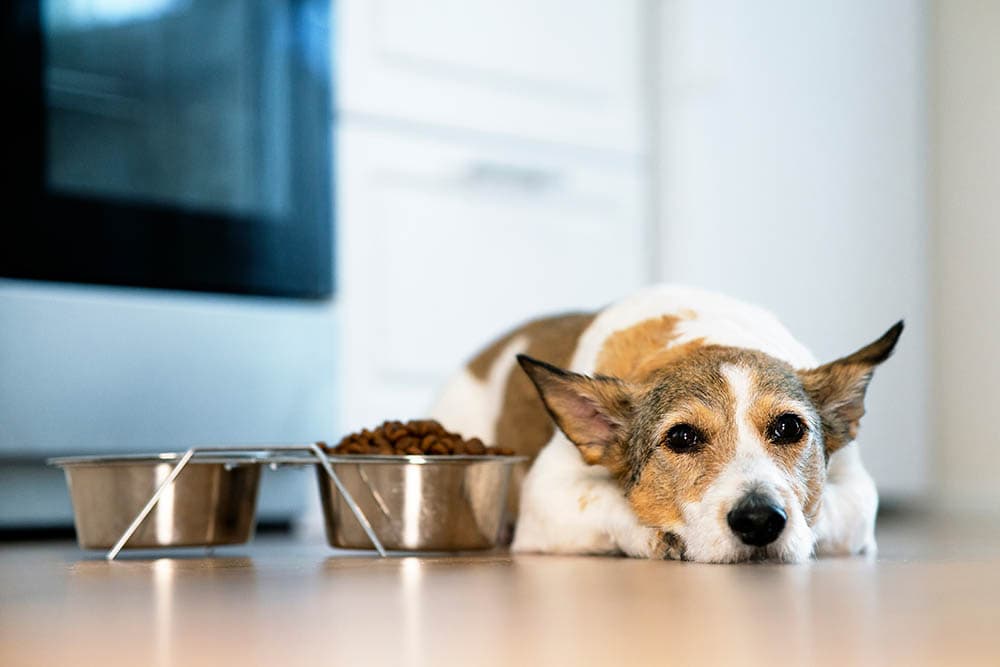
Changing a dog’s food to something they like better is a common reason to change a dog’s food. But it’s funny because I can’t tell you how many people tell me that their dog refuses to eat dog food, but the problem is their dog is also always fat.
Some dogs are very clever, and it may just surprise everyone how easily they can convince you to change their food to something more tasty but less nutritious. Just like us, it is never fun to eat a healthy meal before dessert.
Sometimes, a dog will suddenly decide they no longer want to eat the food they have been enjoying for years. If this happens, you may need to change their food.
But many people overestimate how much their dog should eat, and so when their picky eater doesn’t eat every last scrap, their humans start adding treats and other things to get them to eat more when they probably have just had enough to eat already.
At the other end of the spectrum are the dogs that are always on the verge of apparently starving to near death. If you ask them, there is never enough food in the bowl, and meals should definitely include a second breakfast.
In this case, changing to a lower-calorie food may mean they can eat a larger volume of food without all the extra calories. If they feel they are eating more food, then they might not feel so deprived. Unfortunately, though, this theory tends to only go so far, so take it with a grain of salt.
8. Other Pets in the House
Managing different pets’ nutritional needs can be a challenge. Some dogs have specific nutritional requirements, while others don’t. And it always seems like there is always one sensitive, picky eater living with an absolute food hound who can and does eat everything.
Prioritizing the dog with special nutritional requirements needs to happen, but it can be challenging when others are trying to shove in. Changing everyone’s diet to accommodate the one that has special requirements may be an option but it needs to be carefully considered.
If one dog has allergies, it might be worth changing everyone’s food. It doesn’t matter if dogs without allergies eat foods that are made of different proteins, such as duck or salmon. But it can get expensive, depending on how specialized the hypoallergenic food is.
Also, if one dog is on a specialty diet to treat a chronic disease, it is probably a waste of money and not ideal for everyone to start eating that food.
Instead, it might be better to change how you feed everyone and not what you feed everyone. Here are some ways to change your dog’s feeding routine to accommodate their sibling’s new food:
- Feed at set times on a schedule
- Feed in separate rooms
- Utilize crate time to feed individual diets
- Only feed when you can closely monitor everyone
Final Thoughts
When changing a dog’s food, it takes at least three to five days to make the transition. Changing their food too quickly can also cause problems. But being flexible and adapting when life happens can help your dog live a happier, healthier life.
Featured Image Credit: Jaromir Chalabala, Shutterstock

